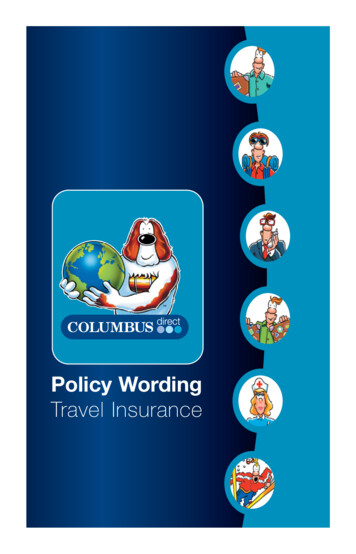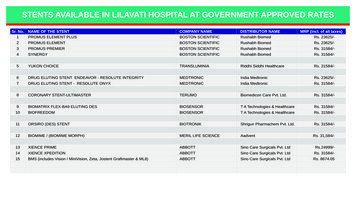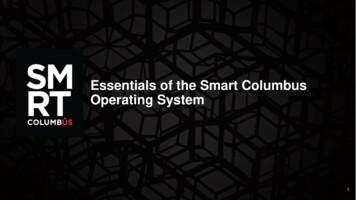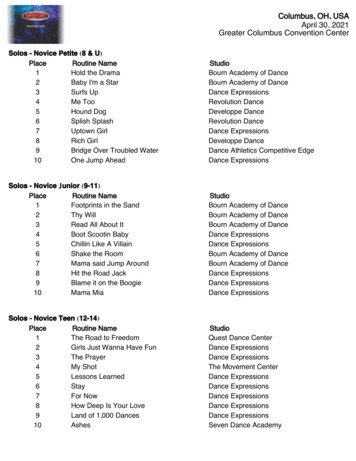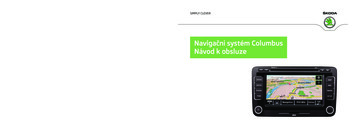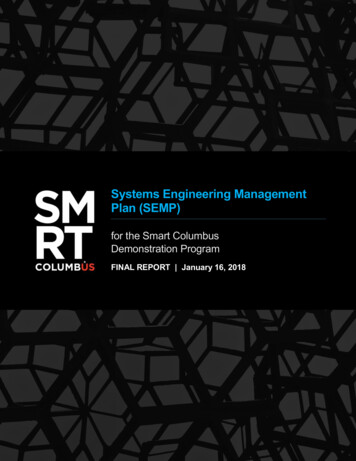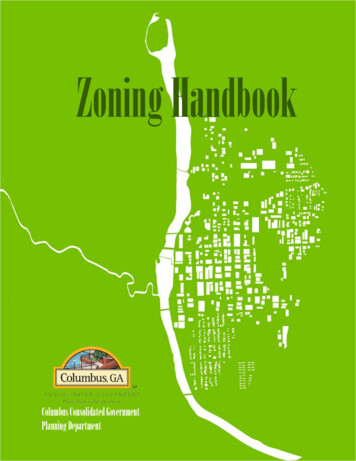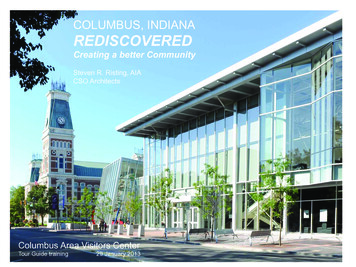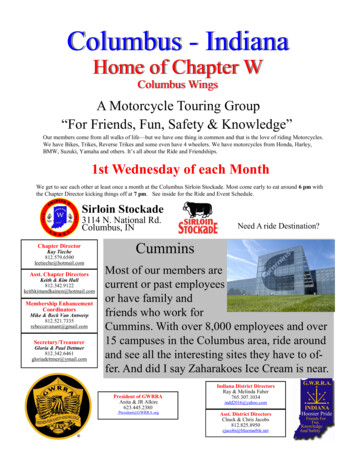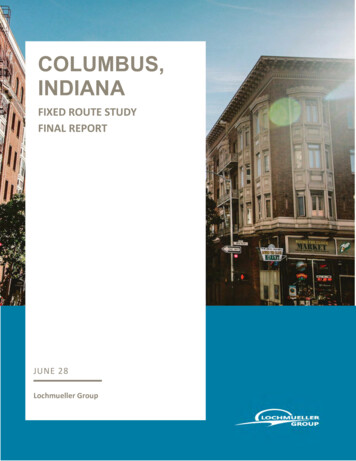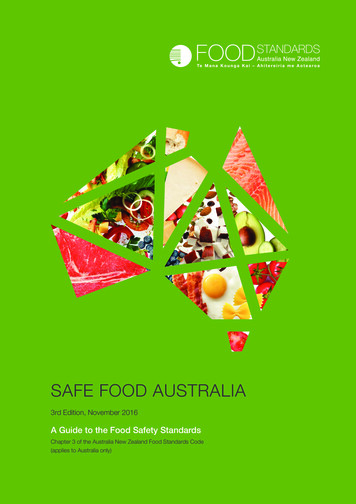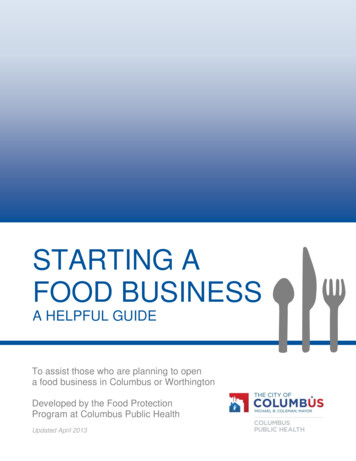
Transcription
STARTING AFOOD BUSINESSA HELPFUL GUIDETo assist those who are planning to opena food business in Columbus or WorthingtonDeveloped by the Food ProtectionProgram at Columbus Public HealthUpdated April 2013STARTING A FOOD BUSINESS GUIDECOLUMBUS PUBLIC HEALTH
GREETINGSWe want you to have a successful business! While this guide has been developed by Columbus PublicHealth (CPH), we have also provided contact numbers for agencies that you may need to get in touchwith to ensure that all proper steps are taken and that the required permits are received.Contacting the agencies below will help you to stay on track and on time. All required permits must beobtained before CPH can issue a food license. For City of Columbus operations, check outwww.bzs.columbus.gov.OFFICESERVICEPHONE NUMBERColumbus Public Health DepartmentPlan review and inspections614-645-6191City of ColumbusBuilding ServicesGeneral Info614-645-6090HVAC/REF Inspection Line614-645-8138Electric Inspection Line614-645-8265Plumbing Inspection Line614-645-8355Structural Inspection Line614-645-8235Find a licensed contractor614-645-7314City of Worthington BuildingDepartmentBuilding permits and inspectionsfor the City of Worthington614-431-2424Ohio Dept of Commerce/Division ofLiquor ControlLiquor License614- 644-2360Ohio Department of TaxationVendor ‘s License - Apply Onlinehttp://business.ohio.govTax ID# (EIN)www.irs.comLicenses wholesale operationsand home bakeries614-728-6250www.ohioagriculture.govOhio Department of AgricultureWhere do I begin?Nearly every new or significantly altered facility serving or selling food or beverages in Columbus orWorthington must submit plans to CPH before a license can be issued. A sanitarian in our Food SafetyProgram will review the plans in order to ensure that the equipment, facilities and design will be suitablefor the food items served or sold at the facility.This guide will help you to determine when you need to submit plans, who you need to get in contactwith, and what to expect as far as process and timeline.STARTING A FOOD BUSINESS GUIDECOLUMBUS PUBLIC HEALTH
PLANNING AHEADWhat is required in my facility?Every business is unique. What will be required will be based on your menu. So, you must make surethat you have the space and equipment needed to store, prepare and serve those foods safely. Manyretail stores will not need the extent of facilities and equipment that a restaurant would need, just assmall operations may not need as much equipment that a larger operation would require.EQUIPMENT YOU WILL NEED (& OTHER ITEMS)Hand washing sinks:All facilities are required to have adequate employee hand washingsinks, conveniently located in each food and dishwashing area, and equipped with soap and disposabletowels or hand dryers. Convenient location indicates that the sink is accessible and visible from anyfood area, including bars and ice dispensing locations such as wait stations. These sinks are requiredto have signs reminding employees to wash hands.Exception: In facilities that serve only prepackaged foods, a hand sink is only required in a restroom.HELPFUL TIP: Each sink described in this section can only be used for its designated purpose(hand washing, dishwashing, food prep, mop sink).Commercial equipment:All equipment used for a retail food operation must be listed ascommercial and must be certified by a recognized testing agency (e.g. NSF, ETL, UL sanitation). Nohousehold equipment is permitted. Casters are required for large equipment if it is not already on legsor permanently fixed (caulked) to the floor with space for cleaning.HELPFUL TIP: Check the label on the equipment or request a specification sheet from thevendor before purchasing. Request casters for larger pieces, such as coolers, to make themeasier to move for cleaning.Dry storage space: Enough space must be planned for storage of food, dishes, and equipment.Ensure that there are designated locations for bulk foods, cans, and other items. All food items mustbe stored at least 6” off the floor, both in walk-in coolers or freezers, and on storage shelving. Metaloffice shelving and raw wood shelves are not allowed. Look for wire racks and food grade shelving.Equipment and single service items (e.g. ‘to go’containers) must be protected from contamination andstored at least 6” off the floor.HELPFUL TIP: Bins for bulk items (e.g. rice, flour) must be made of food grade material andmarked with the type of food inside. Trash cans and non-food grade containers cannot be usedfor bulk food storage.Chemical storage: Chemicals must be stored below and/or away from food items, equipmentand utensils to prevent contamination of these items. Chemicals cannot be stored above thedishwashing sink or on the floor.STARTING A FOOD BUSINESS GUIDECOLUMBUS PUBLIC HEALTH
Employee area:There must be lockers, shelving or a designated area provided only for employeebelongings. Personal belongings such as coats, purses, cigarettes, and phones cannot be kept in food areas.HELPFUL TIP: The employee area is also a great location for storage of employee beveragecups or food.Utility sink:Also called a mop sink or service sink, all facilities are required to have a sinkdesignated for cleaning of mops and cleaning tools, and for disposal of mop water. The utility sink mustinclude a faucet and drain. This sink should have hooks or other means to allow mops to air dry.HELPFUL TIP: A curbed sink provides an easier means to dump mop water, and is a goodstorage spot for the mop bucket when not in use.Adequate lighting:Lighting must be enough in food areas and other areas to allow for safe workconditions and to facilitate cleaning. A guide to general lighting intensity requirements are listed below.50 footcandles: cooking areas, food prep areas, food service areas20 footcandles: customer self service, inside equipment (e.g. reach in cooler), handwashing, dishwashing, utensil storage, restrooms10 footcandles: walk-in coolers and freezers, dry storage, and other areasHELPFUL TIP: When submitting a lighting plan for plan review, it should include (1) type offixtures, (2) location of fixtures, and (3) whether using plastic covers, shields, or shatterproofbulbs to protect food & equipment.Smooth and cleanable surfaces:All floors, walls and ceilings in food areas (service,storage or preparation) must be smooth and easily cleanable. Carpet is allowed only in areas forpackaged food storage.Approved surfaces which are commonly used Floors: quarry tile, ceramic tile, sealed concrete, poured epoxyWalls: stainless steel, FRP, glossy painted drywall, painted concrete blockCeilings: vinyl coated ACT (drop ceiling), glossy painted drywallBase Coving: tile, rubberHELPFUL TIP: Every facility must submit a finish schedule with plan review. Use the examplein the Plan Review Application to help you.Based on your menu and equipment that is used, many facilities will also need Dishwashing sinks:A 3-compartment sink designated for dishwashing is required in anyoperation that sells or serves unpackaged food. The sink should have curved interior edges and atleast three (3) compartments for washing, rinsing and sanitizing. The sink should also have two (2)drainboards, one for collection of dirty dishes and the other for air drying. See the example on page 13.Dishwashers are optional, but a 3-compartment sink is required in a facility that sells or servesunpackaged food. Each compartment of the sink must be large enough to submerge the largest pieceof equipment you have (i.e. a small bar sink would not be acceptable for washing large pots and pans).HELPFUL TIP: Columbus Public Health requires dishwashing sinks and dish tables to beinstalled at least 4 inches off of the wall with brackets.STARTING A FOOD BUSINESS GUIDECOLUMBUS PUBLIC HEALTH
HELPFUL TIP: Try a 4-compartment sink to allow for presoaking!Food processing sink (vegetable sink):Columbus Public Health does not allow foodprocessing in a hand sink or dishwashing sink. A separate sink is required for the processing of produceand other foods. Processing can include washing, soaking, thawing, and using ice baths for cooling. If afood processing sink is not available, a facility will be limited to using only prewashed produce.A food prep sink must have an indirect drain, specifically an air gap, to prevent backflow from a sewagesystem into equipment in which food is placed. The air gap should be twice the diameter of the pipe,but no less than one inch.HELPFUL TIP: Installing a food sink with an integral drainboard will provide you with a foodprep surface for items washed in the sink.Ventilation hoods:A ventilation hood is required at a grill line, or where other cookingequipment and high temperature dish machines are located, to prevent the accumulation of grease,heat, condensation, smoke and vapors.Installation of a ventilation hood requires a permit and inspections. Contact Building Services (phonenumbers on page 2) with questions about ventilation requirements or permits for installation.HELPFUL TIP: Ventilation is always required for gas equipment.Fire suppression system:If a ventilation hood is required because of the use of greaseproducing equipment (fryers, grill, etc), a Type I Hood with fire suppression is required. The firesuppression system acts like a fire extinguisher in case of a grease or cooking fire.If a hood is required for heat, condensation or gas only, a Type II Hood might be allowed. Verify thetype of hood required through Building Services (contact information on page 2).Grease interceptor (grease trap):A grease trap is a device that is attached to sinks and/ordrains to collect fats, oils and grease in order to prevent accumulation in our sewer system. Greasetraps are connected to dishwashing sinks, some floor drains (e.g. at wok lines) and some dishwashers.Grease traps are not a requirement of Columbus Public Health but, if installed, must be easilyaccessible for cleaning. Contact the City of Columbus Department of Sewers and Drains withquestions regarding installation of outdoor vs indoor grease traps.HELPFUL TIP: A grease trap can be a costly installation, and is generally required when adishwashing sink is used. Make sure to research and budget for this item in your planning stages.HELPFUL TIP: Grease traps must be cleaned periodically to keep them working properly. Anindoor grease trap may need to be cleaned monthly/quarterly, while a larger outdoor unit mayonly need cleaning once or twice per year.The Plan Review Application, which you will complete and return to CPH with your plans, will provide achecklist to help you make sure to have the necessary equipment and layout for the operation.STARTING A FOOD BUSINESS GUIDECOLUMBUS PUBLIC HEALTH
RUNNING YOUR BUSINESS (WITH FOOD SAFETYIN MIND)Here are some important questions about how you will safely prepare food for your business that youshould start to think about. These questions may also be asked during future inspections:Employee Training How will you train your staff about food safety?What food safety practices will be covered during staff orientation?What is your employee health policy? What do you do about a sick worker? How will you sharethis policy with employees?Services Who will provide your waste pickup?How will you handle grease waste and cleaning your grease interceptor?Do you have a certified pest control operator?Who will clean your hood system and/or fire suppression system?Who will provide support and maintenance for your dishwasher?Is your facility secure, and is your food supply safe? Do you make sure to use approvedsuppliers? Does your food come from approved sources?Facilities Do you have enough hot water capacity for the busiest time of day?Do you have the storage space needed for dry goods?Do you plan to expand the operation, and will you have the space?Are floors, walls and ceilings constructed with cleanable materials?Equipment Do you have enough space in your coolers and freezers? Can you prevent overstocking andmake certain to allow for air circulation?How will you keep hot foods hot?How will you keep cold foods cold?Have you purchased thermometers for all coolers? Do you have thermometers for taking foodtemperatures?Plan for Easy Cleaning There are several things you can do to prevent the amount of future maintenance necessary for yourfacility and provide ease of cleaning.Have you considered stainless steel on walls at the grill line, and behind and around greaseproducing equipment?STARTING A FOOD BUSINESS GUIDECOLUMBUS PUBLIC HEALTH
Have you placed heavy equipment on casters, so that it can be moved easily? Every other pieceof equipment, especially at the grill line, should be on casters. This makes it easier to cleanbehind and between equipment.Can you avoid sealing equipment and sinks to walls, and instead brace and set equipment awayfrom walls and other equipment? This makes it easier to clean behind 3 compartment sinks,dishwashers, etc. Set equipment at least 4 inches from the wall.Fixed Equipment Is all equipment that is fixed (because it is not easily movable) installed to allow for easycleaning? This means that it must be spaced from nearby equipment or sealed to walls orequipment .Is table mounted equipment that is not easily moveable on legs or sealed to a table?Is all floor mounted equipment (in kitchen areas) that is not easily movable sealed to the floor orelevated on 6 inch legs?Processes What will be your process for date marking ready-to-eat food products?How will you ensure that a ‘first in, first out’ system is used for foods?How will foods be properly thawed? Do you have enough cooler space to allow for overnightthawing?Can large amounts of leftover food be properly cooled? Do you have shallow pans, ice wands, orother necessary tools?Will you keep temperature logs? Who will be responsible? When will you take temperatures?How will you avoid bare hand contact with ready to eat foods? Will you use gloves, tongs,utensils, deli paper, or other tools?All new retail food businesses must complete the plan review process. Here we will walk you throughall of the correct steps to obtain a food service license from Columbus Public Health.FOOD SAFETY EDUCATIONEducating your employees is an important part of planning for a successful food business. The OhioUniform Food Code requires that a Person-in-Charge (PIC) be present during all hours of operation of afood business.The PIC must understand basic food safety concepts, and will need to demonstrate knowledge bycompliance with the food code. This person must make sure that safe food handling practices arefollowed to lower the risk of foodborne illness.Columbus Public Health provides food safety classes that will assist in educating your employees. Weprovide a Level 1 food safety class (4 hours) which reviews the basics of food safety andrequirements of the Ohio Uniform Food Code. We also provide the nationally recognized ServSafe course (16 hours), recommended for all managers.The current schedule and registration form is at www.publichealth.columbus.gov.STARTING A FOOD BUSINESS GUIDECOLUMBUS PUBLIC HEALTH
STEPS TO OPENING YOUR BUSINESSColumbus Public Health reviews facility plans to make sure that the design and equipment in a facilityare proper for the storage, preparation and service of the foods on the proposed menu or food list.Step 1: PLAN REVIEWWho must submit plans?New facilities: New construction and facilities that have never been licensed as a foodoperation in the past.Remodeled or altered facilities: Major changes or alterations such as installation of a walk incooler or ventilation hood, or expanding a kitchen.Change of business: Changes in layout or equipment (example: a new owner converts a bakeryinto a full service restaurant, and grills and ovens have been added to the kitchen).*If you are not sure whether plan review is required, please contact CPH.What is the fee?See page 13 for an updated fee schedule for plan review.What is the process?After we have received your set of plans, application and payment for plan review, CPH will beginreviewing the plans. CPH has up to 30 days to begin the review, but we will do our best to follow yourschedule for opening.If there are any questions about the plans, or changes that need to be discussed, we will contact you(generally by phone or e-mail).When plans are approved, we will notify you (generally by phone or e-mail). A formal approval letterwill follow, and will be mailed to the Plan Review Contact noted on the application.Step 2: LICENSINGOpening Inspection: After plans have been approved and all work is complete, you will need tocontact CPH for an opening inspection. The opening inspection can be conducted once you have allrequired ‘sign-offs’ from the appropriate city departments. (Newly constructed facilities will need tohave final approval from Building Services before a license can be issued.)During the opening inspection, the sanitarian will ask for some information about the license holder(owner) and facility. It is helpful to have business information available, including federal tax ID andowner contact information.Licensing: If there are no outstanding issues, payment will be collected for the license, and aninspection sheet will be given indicating permission to operate. At this point the operation is licensedand approved to operate. The printed license will be sent to you in the mail.License renewal is once a year, and payment for licenses must be received by March 1 every year.Late fees are added after March 1.STARTING A FOOD BUSINESS GUIDECOLUMBUS PUBLIC HEALTH
HOW DO I KNOW WHEN I’M READY FOR MYFINAL INSPECTION?Have you completed all items on this checklist? If YES, you are ready! I have read the ‘Starting a Food Business’ guide to help design my facility based on menu itemsand processes. I submitted plans to the Building Department (Columbus /Worthington). I submitted plans, application and plan fee to Columbus Public Health. I received plan approval from Columbus Public Health and the Building Department. Work was performed by licensed contractors and permits were obtained when necessary. All construction or remodel work is complete. FOR A NEW FACILITY: I have a certificate of occupancy (CO) or temporary CO from the BuildingDepartmentORFOR A REMODEL: I have final approval for any work performed, including inspections and signoffs on permits. I have contacted Columbus Public Health for an opening inspection. Before the scheduled opening inspection: Kitchen/food areas are clean and ready to use. Hot water is available at all sinks. Refrigerated equipment is running at 41ºF or below. The dish machine (if applicable) is in operation. I have the CO or TCO paperwork (from Building Dept) on site. A check or money order is available for the license fee.STARTING A FOOD BUSINESS GUIDECOLUMBUS PUBLIC HEALTH
EQUIPMENT EXAMPLESHANDWASHING SINKREACH-IN REFRIGERATOR3 COMPARTMENT SINKSTARTING A FOOD BUSINESS GUIDECOLUMBUS PUBLIC HEALTH
EQUIPMENT EXAMPLES, CONTINUEDFOOD PREPARATION SINKINDIRECT CONNECTIONCOMMERCIAL DISHWASHERSTARTING A FOOD BUSINESS GUIDECOLUMBUS PUBLIC HEALTH
FEE SCHEDULE (AS OF 1/1/2013)Please make checks payable to the Columbus City Treasurer.PLAN REVIEW FEES 25,000 square feet 25,000 square feetCommercial 400.00 800.00Non-Commercial 200.00 400.00Commercial Risk Level 1 200.00 400.00Non-Commercial Risk Level 1 100.00 200.00Remodel/Alteration 200.00 400.00Risk Level 1 Remodel 100.00 200.00The plan review fee must be submitted with application.FSO & RFELICENSE FEESCommercial 25,000 ft2 25,000 ft2Non-Commercial 25,000 ft2 25,000 ft2Risk Class 1 304.00 412.00 152.00 206.00Risk Class 2 334.00 426.00 167.00 213.00Risk Class 3 584.00 1348.00 292.00 674.00Risk Class 4 714.00 1420.00 357.00 710.00The license fee will be collected at the final inspection. Please do not send it to our office.STARTING A FOOD BUSINESS GUIDECOLUMBUS PUBLIC HEALTH
producing equipment (fryers, grill, etc), a Type I Hood with fire suppression is required. The fire suppression system acts like a fire extinguisher in case of a grease or cooking fire. If a hood is required for heat, condensation or gas only, a Type II Hood might be allowed. Verify the type of hood required through Building Services (contact .
